
The future of carbon-free freight is currently being played out in the Mont-Bloanc Valley with the electric route…
The e-road Mont Blanc project is officially on!
What is “e-road Mont Blanc” project?
eRoadMontBlanc is a research project led by Autoroutes et Tunnel du Mont-Blanc (ATMB). It is the winner of the France 2030 tender “Automated road mobility, connected service infrastructures and low carbon” (« Mobilités Routières automatisées, infrastructures de services connectées et bas carbone ») launched by BPI France.
In order to find alternatives to electric charging stations for charging electric trucks, the creation of electric roads is currently being studied under the name of ERS. An ERS is a system of electrified road for EVs to charge while driving. Several solutions are available, however the partners here involved have opted for underfloor supply technology. This consists of a rail integration within the roadway, associated with a pad on the vehicle.
ALSTOM
ATMB
GREENMOT
PRONERGY
UNIVERSITE GUSTAVE EIFFEL
Conductive (ground-based) system
Conductive charging works both for heavy-duty vehicles and private cars as long as there is a conduction system such as a rail. The vehicles are charged through a stick that touches the rail. Concretely, an electrical rail is milled into the asphalt on which electric trucks lower a moving arm that receives power.
Similar systems are used on trams.
The project aims to demonstrate the interoperability of the infrastructure and to study its sustainability. Several vehicles will be involved to support the demonstration: commercial vehicles, coaches and heavy duty trucks.
GREENMOT will thus provide two of the four vehicles needed: a 40T truck and an intercity bus, retrofitted with electric batteries.

Which advantages for the electric road?

Advantages of electric road are numerous. And this has already been observed in previous experiments. In Sweden, for example, tests have shown that the ERS used on 2% of the road network can reduce CO2 emissions from trucks by 50%. The technology is changing the paradigm of electric transport by making it possible to charge vehicles while they are driving and no longer when they are stationary.
In addition, the ERS helps to reduce the number and size of truck batteries. The optimization of travel costs and the improvement of environmental and payload gains are thus targeted.
Quelles sont les étapes du projet de route électrique ?
The project will take place over 4 years, and is divided into two phases:
1
Phase 1 will lead to the creation of an operational demonstrator in 2024. This will be installed on the TRANSPOLIS experimentation platform in Ain (01). The tests will validate the technologies used and the security of the system.
2
Then, an experimental section will be deployed in Haute-Savoie, on the motorway network of the ATMB concessionaire. More precisely, the demonstrator will be installed on the RN205 which leads to the Mont-Blanc tunnel, for full-scale tests.
